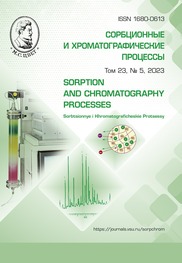Физико-химические свойства суспензий на основе оксида алюминия и перспективы их применения
Abstract
Cordierite blocks of a honeycomb structure with square cross-section channels are used as ceramic carriers for three-route automotive catalysts. Catalytically active layers are applied from suspensions based on γ-Al2O3, which is introduced into the internal volume of the carrier. The preparation of suspensions included impregnation of Al2O3 powder with solutions of Pt, Eu precursors, dilution with water, grinding to particles with an average size of 4 microns, setting acidity in the required range.
The study of the physicochemical properties (point of zero charge, specific surface area, particle size, pore volume, average pore diameter) of a suspension prepared on the basis of aluminium oxide and modified with europium and platinum ions is relevant due to the possibility of using three-path catalysts in technology.
The surface and porosity parameters were determined by low-temperature nitrogen adsorption/desorption.
pHzcp values were determined by gravimetric titration, the pH of the points were in the range of 6.01-7.1, therefore, the specified acidity range should not be beyond these limits. The processes of thermal destruction of suspensions during heating were studied by thermal analysis. During the heating process from -100 to 250°C, a weight loss was observed throughout the heating process. Endothermic effects were discovered, corresponding to the melting of ice, evaporation of moisture, and decomposition of nitrogen-containing compounds. The greatest weight loss was observed in an aluminium oxide sample modified with europium and platinum ions (Eu,Pt/γ-Al2O3). Quantitative assessment of the forms of moisture bonds in the suspension was carried out using experimental dependences on weight changes of the TG sample and the rate of change in the DTG weight in the temperature range of 270-380 K. Based on the activation energy values, it was established that the mechanism of moisture release from the Eu,Pt/γ-Al2O3 differs from others. The calculated activation energies for the release of moisture was high (41-92 kJ/mol), which indicates the bound state of water in the structure of the solid phase. The suspension was applied to a ceramic catalyst base and annealed at 500 °C, information about the mechanism of moisture release during heating of the suspension will help to avoid a decrease in the specific surface area.
Downloads
References
Alikin E.A., Bochkarev S.Yu., Denisov S.P. Development of thermostable composition of Al2O3–Ce0,75Zr0,25O2 for use in three-ways exhaust cars gas cleaning catalyst. Catalysis in industry, 2012; 2: 25-34.
Kanazawa T. Development of hydrocarbon adsorbents, oxygen storage materials for three-way catalysts and NOx storage-reduction catalyst Catal, Today, 2004; 96(3): 171-177.
Ivanov V.K., Shcherbakov A.B., Baranchikov A.E., Kozik V.V. Nanocrystalline Cerium Dioxide: properties, preparation, application. Tomsk, Tomsk University Publ., 2013, 284 p. (In Russ.)
Favre C., Zidat S. Emission Systems Optimization to Meet Future European Legislation. SAE Technical Paper Series 2004-01-0138.
Burtin P., Brunelle J.P., Pijolat M., Soustelle M. nfluence of surface area and additives on the thermal stability of transition alumina catalyst supports. I: Kinetic data. Applied Catalysis, 1987; 34: 225-238.
Ismagilov Z.R., Shkrabina R.A., Koryabkina N.A. Preparation and study of thermally stable washcoat aluminas for au-tomotive catalysts. Studies In Surface Sci-ence and Catalysis, 1998; 116: 507-511.
Chuech J.S., Cant N.W. Stabilisation of aluminas by rare earth and alkaline earth ions. Applied Catalysis A: General, 1993; 101: 105-116.
Slepterev A.A., Tsyrulnikov P.G. Palladium catalysts based on alumina mod-ified with REE oxides. Omsk Scientific Bulletin, 2013; 1(117): 51-54. (In Russ.)
G. A. Parks and P. L. de Bruyn: The Zero Point of Charge of Oxides. .J. Phys. Chem., 1962; 66(6): 967-973.
Pechenyuk S.I., Semushina Yu.P. The calculation of composition for mechanical mixture sorbent. Sorbtsionnye i khromatograficheskie protsessy. 2019; 19 (1): 45-51 (In Russ.)
Kosmulski M. The pH-dependent surface charging and the points of zero charge. J. Colloid and Interface Sci, 2002; 253(1): 77-87.
Trueba M., Trasatti S.P. γ-Alumina as a Support for Catalysts: A Review of Fundamental Aspects. Eur. J. Inorg. Chem, 2005; 3393-3403.
Patel M.A., Kar A.S., Raut V.V. De-lineating the influence of picolinic acid on Eu(iii) sorption by γ-alumina. Environ Sci Process Impacts, 2020; 22(2): 329-339.
Tan X.L., Wang X.K., Geckeis H., Rabung Th. Sorption of Eu(III) on Humic Acid or Fulvic Acid Bound to Hydrous Alumina Studied by SEM-EDS, XPS, TRLFS, and Batch Techniques. Environ Sci Technol, 2008; 42(17): 6532-6537.
Cai Y., Ren X., Lang Y., Liu Z. Re-traction: Sequestration and speciation of Eu(III) on gamma alumina: role of temper-ature and contact order. Environ Sci Process Impacts, 2015; 17(11): 1904-1914.
Mostalygina L.V., Mostalygin A.G., Kostin A.V. Identifying the point of zero charge of bentonite clay Zyryansky deposits by weight titration. Bulletin of Kurgan State University. Series: Natural sciences, 2012; 3 (25): 107-110.
Saranov I.A., Niftaliev S.I., To-roptsev V.V., Kuznetsov I.A. Investigation of the quality of water in the process of its purification using ultrafiltration by the method of differential scanning calorimetry Bulletin of the Voronezh State University of Engineering Technologies, 2021; 83(87): 323-329. (In Russ.)
Kotov V.V., Sokolova S.A., Netesova G.A. Condition of water in aro-matic polyamide membranes.Journal of Physical Chemistry, 2005; 79(10): 1896-1901. (In Russ.)
Beguin B., Garbowski E., Primet M. Stabilisation of Aluminia by Addition of Lanthanum. Appl. Catal. 1991; 75: 119-121.
Ahlstrom-Silversand A.F., Odenbrand C.U.I. Combustion of methane over a Pd-Al2O3-SiO2 catalyst, catalyst activity and stability. Applied Catalysis A: General, 1997; 153(1-2):157-175.
Dzisko V.A., Karnaukhov A.P., Tarasova D.V. Physico-chemical bases of synthesis of oxide catalysts. Novosibirsk, Nauka. 1978, 384 p. (In Russ.)
Williamson W.B., Richmond R.P., Nunan J.G. Palladium and Plati-num/Rhodium Dual-Catalyst NLEV and Tier IIa Close-Coupled Emission Solutions. SAE World Congress, March 5-8, 2001, Detroit, Michigan, SAE Technical Paper Series 2001-01-0923, pp. 1-11.







